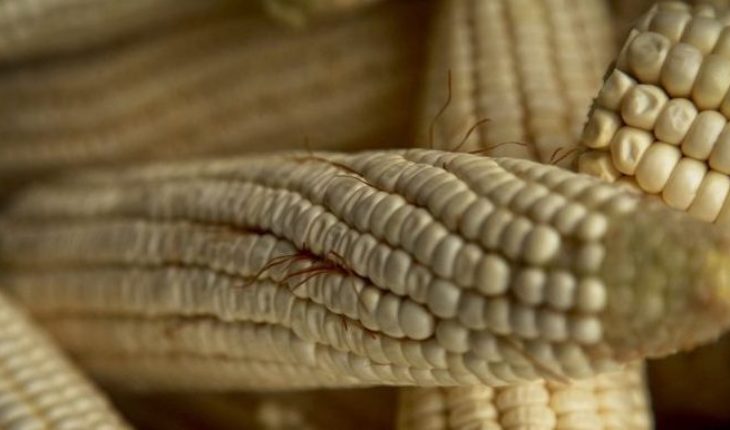in the Sierra Mixe of Oaxaca there is a corn genetic characteristics are unique: does not require fertilizers-agrochemicals for its production, giving it a huge commercial potential to scale world. Big food business.
This kind of corn was developed, over the centuries, using ancient techniques of seed selection applied by the indigenous peoples of Oaxaca.
However, the universities Davis of California and Wisconsin-Madison (United States private institutions) and the company Mars Inc. (owner of brands like Snickers, Pedigree, Wiscas, Orbit, M & M and Milky Way) claimed in a scientific publication that were they who discovered this type of maize.
However, according to official documentation collected by political Animal through the National Institute of access to public information (INAI), the universities and the transnational company undertook investigations of the Sierra Mixe corn without with the authorization of the Mexican Government.
In a nutshell, “they pirated” the genetic characteristics of the mixe corn to apply it in other species.
The Secretariat of environment and natural resources (Semarnat) announced through a press release – in August last, “discovery” made by the universities and the company, in conjunction with the technological Institute of the Valley of Oaxaca (from SEP).
According to Semarnat, the research that led to this discovery not only attended all official authorisations required for their development, even made respecting the Nagoya Protocol, international instrument that seeks to ensure the Division fair and equitable profits to Governments or companies can be achieved through the use of biological and genetic resources to develop food products, pharmacists or others.
Dependence stressed that the distribution of profits which will generate the exploitation of this Oaxacan maize was accepted by “the community of the Sierra Mixe”, which, he said, it gave its consent “prior, informed, and established the mutually agreed terms for the” sharing of the benefits arising from it”, the beginning of this research with native corn, for both its future commercial exploitation.
But the reality was different: there was no authorization of the Mexican Government, nor of the Oaxacan peoples to study maize.
In fact, the permission to take samples of corn of the Sierra Mixe transacted several years since these were taken from Mexico, and only until then that the corn would be reproduced successfully in the United States.
On the right, Frank Mars, Member of the U.S. company whose report does not clarify how detected the existence and potential of corn. Photo: AFPLas universities boast its discovery Davis, Wisconsin-Madison universities and transnational Mars Inc. presented the results of the research in the Sierra Mixe as a “revelation” scientific, although in the article from Plos Biology Journal recognized that this kind of “Creole” corn was developed using ancestral techniques of seed selection applied by the indigenous peoples of Oaxaca, for centuries.
In the article, research group recognized that the three varieties of maize submitted to study are “locally grown” in the Sierra Mixe, and “known as (corn) red, white stone and plain”.
In Mexico, the Creole maize varieties “are common goods, belong to the community”, explains in an interview Dr. Yolanda Massieu Trigo, specialist of the Universidad Autónoma Metropolitana in sustainability and food sovereignty.
The varieties of maize, details, are those that will develop in the towns, in rural regions, from seed selection processes which have existed since thousands of years, “and in the villages, there are people who will be doing their own experiments, “selecting seed, and they are known by their neighbors, who share and exchange seed, then, why Creole maize varieties do not belong to one person, but to all, is a collective property”.
These communities, says the specialist, “are at the mercy of private companies that you are looking for that collective property become individual intellectual property for profit”.
The investigation report does not clarify how the universities Davis, Wisconsin-Madison, and Mars Inc. detected the existence and potential of this maize of Oaxaca, just point out that “native varieties isolated from maize in the region, we learned Sierra Mixe of Oaxaca” “which, according to the reports, were cultivated using traditional practices with little or no fertilizer”.
It was the private group determined start in the Sierra Mixe a field investigation, in search for the “Holy Grail” of the world agricultural industry, because of the “economic importance” that can achieve a variety of corn that prescinds from added fertilizer.
Research conducted by this scientific panel concluded that, regardless of the place in which they are planted, these “races” of the Sierra Mixe corn don’t need nitrogen fertilizer (used to stimulate the growth of the plant), since for grow taken nitrogen directly from the environment, thanks to associations that engages with microorganisms attracted to the plant.
Samples of corn ‘irregular’ after the ‘discovery’, Mars Inc. said in a bulletin that “this research was facilitated by the tremendous cooperation from the Secretariat of environment and natural resources and of the Secretariat of agriculture, livestock, development Rural, fisheries and food (Semarnat and Sagarpa, the Mexican Government) “and stressed that the municipal authority and the” community in the village in the region of Sierra Mixe “where the study was conducted”were an integral part of this research project”.”
Mars Inc. also ensures that, thanks to the approval of the community that lives in that “isolated village”, whose name unclear, “you agreed to the biological materials and we used them, according to an agreement for access and sharing of benefits with the community, and with the” permission from the Mexican Government.”
However, the dates don’t add up.
The scientific study published by Mars Inc. and two American universities ensures that sampling was initiated in 2006 and that experiments with the Sierra Mixe corn began in 2010, when this type of corn was grown on the campus of the University Wisconsin-Madison, United States.
Then, the study points out that the “observations” made took five years, i.e. until 2015. These observations led to experiments that continued until 2017.
According to dates reported by the same private scientific group, the permission to obtain samples and begin studies had to have been requested and obtained prior to the initiation of the investigation, i.e., before 2006.
However, permission transacted before the Mexican Government by the company BioN2, a subsidiary of Mars Inc. (of which Animal politician has copy), was requested and obtained by 2015, i.e., nine years after the samples were taken and extracted from Mexico, and when East scientific research team had already completed its observations.
According to articles 87 and 87 Bis of the General Law of ecological balance, before starting any type of research on biological resources (as in this case is the maize of the Sierra Mixe) Mexican, interested parties must obtain a permit for the lifting of samples, and there are two types: one for non-profit projects and the other for research pursuing a commercial benefit.
The official Mexican 126-ECOL-2000, which regulates the scientific collection of material and biological resources in the Mexican territory, points out that these permits should be processed until start the lifting of samples, and the applicant must comply with various conditions, before and after making its lifting of biological resources.
To apply for a permit the interested party must previously obtain a license as “scientific collector”. Already with this license, the applicant must describe before the Semarnat what are the objectives and scope of your research and demonstrate that it has “Express, prior and informed consent” of the legitimate holder of the biological resource in question.
If you meet these requirements, the person concerned can obtain permission for the lifting of samples, but collapses an obligation: to the end of the process, should share a part of those samples with any Mexican scientific institution.
If this requirement is not met, the Norma Oficial establishes that scientific collector can not provide these samples to “foreign collections”. In addition, this standard requires authorized scientific collectors to deliver an annual report of its work to the Semarnat.
Mars Inc. and universities Davis or Wisconsin-Madison failed with these requirements.
Semarnat Animal politician informed that this group not requested permission to start its lifting of samples in 2006, and that to date it has not issued any permission related to the maize of the Sierra Mixe and their associated microorganisms.
SEMARNAT stressed that the only existing permission is accorded by 2015, and that it was issued by a different public body: the national service of inspection and certification of seed, dependent on the Secretariat of agriculture, livestock, Rural Development, fisheries and Food (Sagarpa).
In addition, other irregularities: when that permission was transacted, in 2015, the national service of inspection and certification of seeds consulted with Semarnat so “will give with respect to the request for access, collection and export of seeds and plants carried out by the legal representative of the company BioN2 Inc. “.”
According to the official documentation, which was obtained copy, Semarnat replied that the issue was “outside its sphere of competence”, even cuaWhen the General Law of ecological balance identifies this dependency as the empowered to authorize the collection of Mexican resources and biological and genetic material.
But this investigation was initiated without authorization from the Mexican Government, also private not only U.S. concluded without this realized.
Consulted by political Animal, both the Semarnat and Sagarpa revealed that they do not have any report of the group, formed by universities, and Mars Inc., in which presented the conclusions reached after the experiments with the Sierra Mixe maize and its associated microorganisms.
Semarnat acknowledged that he met the research results of universities and Mars Inc. only until they were announced in the United States, on 7 August, when published a scientific paper in the journal Plos Biology Journal that referred to the potential of this “Holy Grail” of the International Grains industry.
After the publication in the journal, the Head Office of the transnational Mars Inc. (headquartered in Virginia, United States) released a bulletin in which welcomed the discovery.
Adds that there is still time to move this feature of the Sierra Mixe corn “commercial maize”, but predicts that its potential markets are “developing” countries with little access to nitrogen fertilizer, although obviously it could be sold to any producer of the world who does not want to keep paying for fertilizers-agrochemicals.
Permissions must be processed before that to start the lifting of samples, and the applicant must meet various conditions. Photo: CuartoscuroOro by mirrors the official documentation also points out that it is untrue that the indigenous communities of the 17 municipalities that make up the Sierra Mixe of Oaxaca have been consulted previously with respect to the initiation of the investigation and, therefore, not There is an authorization of all the indigenous peoples of the area for their genetic resources are extracted and exploited commercially.
The Semarnat, the Ministry of public education, the technological Institute of Oaxaca, the Secretary of agriculture, the National Commission for the development of indigenous peoples, as well as the national system for the inspection and certification of seed (unique institutions empowered to authorize this type of research, or to authorize the marketing of Mexican genetic resources), reported that when the Sierra Mixe corn was extracted from Mexico, none of these procedures had been authorized by the authorities.
According to the Nagoya Protocol, indigenous peoples should establish, together with the Group of researchers, an agreement for the distribution of the benefits of research.
Political animal requested to Semarnat (dependency that must verify the Nagoya Protocol is applied correctly) a copy of the agreement signed between “the community of the Sierra Mixe” and Mars Inc., and endorsed by the Mexican authorities, to meet its terms.
SEMARNAT responded that it does not have copy of the agreement and informed that never verified its content, since it was an agreement “between individuals”.
Political animal approached the Semarnat to know how did this government agency to determine that the agreement was fair and equitable to the community of the Sierra Mixe, as required by the Nagoya Protocol, if he never met the terms of the agreement. There was no response.
Also requested a copy of the consultation between the indigenous peoples of the area, which was obtained their consent to the project of Mars Inc.
The Semarnat answered that query, never became since the Nagoya Protocol does not oblige to make queries to obtain consent “prior informed”.
The federal agency also clarified how obtained the consent of the peoples of the Sierra Mixe, if it was not asking if they granted it.
The national service of inspection and certification of seed, Sagarpa, pointed out in his C00.03.2141 Office, that the “fair and equitable” sharing agreement does not require “ratification or registration” before this national service. Therefore, neither this government agency verified if this agreement was really fair to the indigenous peoples of the Sierra Mixe.
The omissions do not end there. Federal laws require every public body to put to consultation of the National Commission for the development of indigenous peoples any policy or Government action that affects the life or territories of these communities. However, this does not happen.
The National Commission for the development of indigenous peoples reported that no government agency notified about the research project of the Sierra Mixe commercial corn, nor had been consulted with his opinion.
Then, what indigenous communities of the Sierra Mixe approved this project of Mars Inc., if they really exist? And what was that Mars Inc. offered to residents of this isolated ‘village’, in Exchange for corn developed using traditional techniques and for generations?
Mars Inc. refused to give an interview, but sent a letter to political Animal in which ensures that it cannot provide the name of “the”indigenous community of the Sierra Mixe which gave its consent, to “maintain your privacy”.
In his letter, Mars Inc. not not clear what offered to the community in Exchange for corn and knowledge associated with its use.
In the letter, however, there is a relevant piece of information: Although the Mexican authorities claimed that they did not know the content of the agreement, because it is a matter between “individuals”, Mars Inc. revealed that that agreement was also established with “the authority municipal”, although it omits to disclose which City Hall is.
That means that this wasn’t just between individuals, as if Mexican authorities were involved.
Staying hidden name allegedly involved municipalities, both the Mexican authorities as Mars Inc. guarantee that this transaction is outside public scrutiny.
Also sought out another of those involved: the technological Institute of the Valley of Oaxaca, public academic body which, according to Semarnat, was part of the scientific team that developed the research on maize in the Sierra Mixe.
The Institute, affiliated to the Ministry of education, said that it had nothing to do with this investigation, or the alleged irregularities implied, although he acknowledged that the scientific article in which the facts were disclosed was signed, among others, by one of its scholars: Professor Javier López Baltazar, who also responded to the request for interview.
Specialist at the Metropolitan Autonomous University, Yolanda Massieu, ensures that it is worrisome that both Mars Inc. as the authorities keep secret with who made these so-called agreements, “only speak of the ‘ community of the Sierra Mixe’, but not ‘ say what, nor nor local authority participated in all this, a curator of community property, a Municipal Assembly, a municipal Presidency? “.”
None of these authority figures, clarifies, can exercise control over common goods, whose possession all the indigenous peoples of Oaxaca share.
Keep this fact secret, underlines, prevents go to the place and ask directly with those responsible for what was delivered to a transnational Mexican heritage and ancestral knowledge associated with it.
“We hope not to be facing a case of biopiracy, simulated by the authorities,” he concludes.
translated from Spanish: Two EU universities and a company hack Oaxacan corn
November 5, 2018 |





